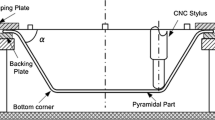Abstract
Decomposing 3-D geometries into flat layouts is a two-step process; specifically, its generation and analysis. The generation phase employs graph traversal procedures to extract the topological information from the parent-folded (or 3-D geometry) structure. This manuscript investigates the role of the graph traversal approaches in generating such layouts with application to folded sheet metals. The study executes several graph traversing routines and then examines the generated layouts for manufacturability considerations and product cost. The specific search routines included in this study are the depth-first search, the breadth-first search, the Prim’s algorithm, the A* search, in addition to routines based on enumerating the minimum spanning trees only, and enumeration algorithms that work on all spanning trees. The study exposes the role of such routines in controlling the proposed flat layout(s) manufacturability and cost. Additionally, the study examines the compatibility of some folded sheet metal designs (i.e., its geometry type: manifold and non-manifold) for each of the aforementioned algorithms.
Similar content being viewed by others
References
Kalpakjian S, Schmidt S (2006) Manufacturing engineering and technology, 5th edn. Prentice Hall, New Jersey
Shpitalni M, Lipson H (2000) 3-D conceptual design of sheet metal products by sketching. J Mater Process Technol 103:128–134
Albrecht Dürer (1977) The Painter’s manual: a manual of measurement of lines, areas, and solids by means of compass and ruler assembled by Albrecht Dürer for the use of all lovers of art with appropriate illustrations arranged to be printed in the year MDXXV. Abaris Books, Inc., New York. English translation of Unterweysung der Messung mit dem Zirkel un Richtscheyt in Linien Ebnen und Gantzen Corporen, 1525
Hull T (1994) On the mathematics of flat origami’s. In: Proceedings of the Southeastern International Conference on Combinatorics, Graph Theory & Computing, Boca Raton, Florida (pp. 215–224)
Hull T (1996) A Note on ‘impossible’ paper folding. Am Math Mon 103(3):240–241
Bern M, Hayes B (1996) The complexity of flat origami. In: proceedings of the 7th Annual ACM-SIAM Symposium on Discrete Algorithms, Atlanta, Georgia (pp 175–183)
Lang R (1996) A computational algorithm for origami design. In: Proceedings of the 12th Annual ACM Symposium on Computational Geometry, Philadelphia (pp. 98–105)
Lee Y, Tor S, Soo E (1996) Mathematical modeling and simulation of pop-up books. Comput Graph 20(1):21–31
Elsayed E, Basily B (2004) A continuous folding process for sheet materials. Int J Mater Prod Technol 21:217–238
Shephard G (1975) Convex polytopes with convex nets. Math Proc Camb Phil Soc 78:389–403
O’Rourke J (1998) Folding and unfolding in computational geometry. In: Proceedings of Japan Conference on Discrete and Compuational Geometry 1763
Horiyama T, Shoji W (2011) Edge unfoldings of platonic solids never overlap. 23rd Canadian Conference on Computational Geometry (CCCG). Toronto, Canada
Chuang SH, Huang SF (1996) Feature decomposition from solid models for automatic flattening. Computer-Aided Design 28(6/7):473–481
Lin YL, Yang DC (1998) Flat pattern generation of thin-walled objects based. Proc Inst Mech Eng—Part B J Eng Manuf 212(4):325–334
Liu W, Tai K (2002) Computational geometric modeling and unfolding of 3-D folded structures. In: Proceedings of the ASME Design Engineering Technical Conferences (28th Design Automation Conference), paper no. DETC2002/DAC-34046
Tai K, Liu W, Thimm G (2004) Unfolding and flat layout design of non-manifold 3-D folded structures. Comput Aided Des Appl 1(1–4):439–447
Liu W, Tai K (2007) Optimal design of flat patterns for 3-D folded structures by unfolding with topological validation. Comput Aided Des 39:898–913
Johnson W, Yu T (1980) The angle of fold and the plastic work done in the folding of developable flat sheet metal. J Mech Eng Sci 22(5):233–241
Schenk M, Guest S (2011) Origami folding: a structural engineering approach. In: Origami 5: Fifth International Meeting of Origami Science, Mathematics and Education, (pp 291–303)
Gross JL, Yellen J (2006) Graph theory and its applications. Chapman and Hall/CRC Taylor Francis, London
Yamada T, Kataoka S, Watanabe K (2010) Listing all the minimum spanning trees in an undirected graph. Int J Comput Math 87(14):3175–3185
Gabow H, Myers E (1978) Finding all spanning trees of directed and undirected graphs. SIAM J Comput 7:280–287
Shioura A, Tamura A, Uno T (1997) An optimal algorithm for scanning all spanning trees of undirected graphs. J Comput 26(3):678–692
Author information
Authors and Affiliations
Corresponding author
Rights and permissions
About this article
Cite this article
Qattawi, A., Mayyas, A. & Omar, M.A. An investigation of graph traversal algorithms in folded sheet metal parts design. Int J Adv Manuf Technol 69, 2237–2246 (2013). https://doi.org/10.1007/s00170-013-5181-9
Received:
Accepted:
Published:
Issue Date:
DOI: https://doi.org/10.1007/s00170-013-5181-9




